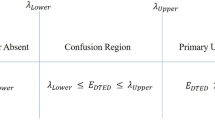Abstract
Spectrum sensing with improved reliability is the key for realizing dynamic spectrum access through cognitive radio systems. In this paper, an optimization problem is formulated to determine multiple threshold values for cooperative spectrum sensing in cognitive radio networks. Fuzzy entropy maximization on sensed energy is suggested as solution. Two methods, namely selection combining (SC) and maximum ratio combining (MRC) at fusion center are studied to obtain the value of the resultant sensing energy. A set of parameters on energy values are used to define different fuzzy functions that indicate different degree of presence and absence of primary user (PU). The parameters are then searched for optimal values that maximize fuzzy entropy using differential evaluation algorithm. Simulation results at low signal-to-noise ratio (SNR) are shown to highlight the efficacy of using multiple threshold values over single threshold. Simulation results also demonstrate the effects of increase in receiver diversity and the number of PU samples on detection reliability. Results shown shed a light on the choice of SC or MRC depending on the value of operating SNR to resolve the trade-off in detection reliability and energy requirement.















Similar content being viewed by others
References
Akyildiz, I. F., Lo, B. F., & Balakrishnan, R. (2011). Cooperative spectrum sensing in cognitive radio networks: A survey. Physical Communication, 4(1), 40–62.
Federal Communications Commission. (2002). Spectrum Policy Task Force, Rep. ET Docket no. 02–135.
Fanzi, Z., Li, C., & Tian, Z. (2011). Distributed compressive spectrum sensing in cooperative multihop cognitive networks. IEEE Journal of Selected Topics in Signal Processing, 5(1), 37–48.
Ghozzi, M., Marx, F., Dohler, M., & Palicot, J. (2006). Cyclostatilonarilty-based test for detection of vacant frequency bands. In 1st International conference on cognitive radio oriented wireless networks and communications (pp. 1–5).
Haykin, S. (2005). Cognitive radio: Brain-empowered wireless communications. IEEE Journal on Selected Areas in Communications, 23(2), 201–220. doi:10.1109/JSAC.2004.839380.
Huang, S., Chen, H., Zhang, Y., & Zhao, F. (2012). Energy-efficient cooperative spectrum sensing with amplify-and-forward relaying. IEEE Communications Letters, 16(4), 450–453.
Li, L., & Chigan, C. (2014). Fuzzy c-means clustering based secure fusion strategy in collaborative spectrum sensing. In IEEE international conference on communications (ICC) (pp. 1355–1360).
Lim, T. J., Zhang, R., Liang, Y. C., & Zeng, Y. (2008). GLRT-based spectrum sensing for cognitive radio. In IEEE global telecommunications conference (pp. 1–5). doi:10.1109/GLOCOM.2008.ECP.842.
Lopez-Benitez, M., & Casadevall, F. (2012). Improved energy detection spectrum sensing for cognitive radio. IET Communications, 6(8), 785–796. doi:10.1049/iet-com.2010.0571.
Mishra, S., Sahai, A., & Brodersen, R. (2006). Cooperative sensing among cognitive radios. In IEEE international conference on communications, ICC (Vol. 4, pp. 1658–1663).
Mohammadi, A., Taban, M. R., Abouei, J., & Torabi, H. (2013). Fuzzy likelihood ratio test for cooperative spectrum sensing in cognitive radio. Signal Processing, 93(5), 1118–1125.
OFCOM. (2007). Digital dividend review, a statement on our approach towards awarding the digital dividend. http://stakeholders.ofcom.org.uk/binaries/consultations/ddr/statement/statement.pdf.
Qihang, P., Kun, Z., Jun, W., & Shaoqian, L. (2006). A distributed spectrum sensing scheme based on credibility and evidence theory in cognitive radio context. In IEEE 17th international symposium on personal, indoor and mobile radio communications (pp. 1–5).
Qin, A. K., Huang, V. L., & Suganthan, P. (2009). Differential evolution algorithm with strategy adaptation for global numerical optimization. IEEE Transactions on Evolutionary Computation, 13(2), 398–417.
Tandra, R., & Sahai, A. (2005). Fundamental limits on detection in low SNR under noise uncertainty. In International conference on wireless networks, communications and mobile computing (Vol. 1).
Tao, W. B., Tian, J. W., & Liu, J. (2003). Image segmentation by three-level thresholding based on maximum fuzzy entropy and genetic algorithm. Pattern Recognition Letters, 24(16), 3069–3078.
Tian, Z., & Giannakis, G. (2006). A wavelet approach to wideband spectrum sensing for cognitive radios. In 1st International conference on cognitive radio oriented wireless networks and communications (pp. 1–5).
Tseng, P. K., Chung, W. H., & Hsiu, P. C. (2013). Minimum interference topology construction for robust multi-hop cognitive radio networks. In IEEE wireless communications and networking conference (WCNC) (pp. 101–105).
Wang, L., Wang, J., Ding, G., Song, F., & Wu, Q. (2011). A survey of cluster-based cooperative spectrum sensing in cognitive radio networks. In Cross strait quad-regional radio science and wireless technology conference (CSQRWC) (Vol. 1, pp. 247–251).
Yang, W., Cai, Y., & Xu, Y. (2007). A fuzzy collaborative spectrum sensing scheme in cognitive radio. In International symposium on intelligent signal processing and communication systems (pp. 566–569).
Yucek, T., & Arslan, H. (2009). A survey of spectrum sensing algorithms for cognitive radio applications. IEEE Communications Surveys Tutorials, 11(1), 116–130.
Zhang, H., & Wang, X. (2011). A fuzzy decision scheme for cooperative spectrum sensing in cognitive radio. In IEEE 73rd vehicular technology conference (VTC Spring) (pp. 1–4).
Author information
Authors and Affiliations
Corresponding author
Rights and permissions
About this article
Cite this article
Chatterjee, S., Maity, S.P. & Acharya, T. On Optimal Threshold Selection in Cooperative Spectrum Sensing for Cognitive Radio Networks: An Energy Detection Approach Using Fuzzy Entropy Maximization. Wireless Pers Commun 84, 1605–1625 (2015). https://doi.org/10.1007/s11277-015-2550-8
Published:
Issue Date:
DOI: https://doi.org/10.1007/s11277-015-2550-8




